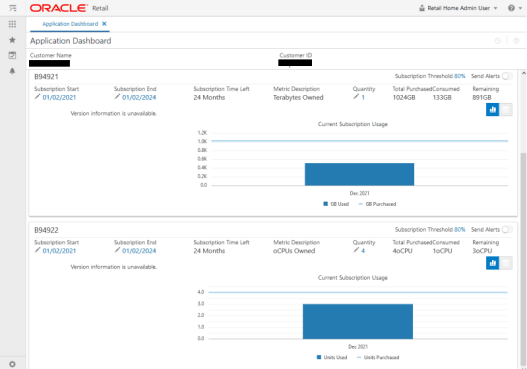2 Storage and CPU Usage
For each Retail Analytics and Planning instance, the database disk storage and CPU usage is tracked. Your current usage levels can be seen by logging in to Oracle Retail Home and viewing the Application Dashboard. On the list are two entries: one for CPU Usage, and one for Disk Usage. The entries show current usage and also display the currently subscribed amounts for CPU and storage, so a customer can see whether they are nearing their subscription limits. The usage is tracked on a weekly basis, so updates to these charts happen about four times per month. This UI can only be viewed by Retail Home administrator users. Refer to the Retail Home product documentation for more information.

The storage metric is derived from the total allocated tablespace in the Autonomous Data
Warehouse (ADW) in each of your environments. ADW will automatically allocate space
based on your usage of Oracle cloud applications, and this allocation cannot be directly
altered. Allocated space will always be larger than the currently consumed tablespace at
the table or schema level, as it includes space used for temporary objects and Oracle
database features such as flashback and restore capabilities. Once allocated, tablespace
will not typically go down, but it will be re-used if data is purged from the database.
This is an Oracle-managed Software-as-a-Service (SaaS) database instance, meaning you
will not have administrative access to the database, and you may not alter system
objects or configurations. You do have read-only access to most system tables and views,
such as DBA_SEGMENTS, if you wish to analyze your current tablespace
usage in more detail.
If using database metadata views like DBA_SEGMENTS for reviewing
information about disk space and usage, limit the analysis to the Analytics and Planning
application users only, as these are the only ones directly affected by the data you
load and the applications you use. Other database users and objects are managed by ADW
or other Oracle components and are outside of a customer’s control. The table below
lists the application users and their primary purpose.
| Database User | Purpose |
|---|---|
| RADM01 | Primary data warehouse user that retains all foundation and history data loaded to your environment. Used for all Retail Insights reporting and inbound data transformations for all Retail Analytics & Planning (RAP) applications. |
| RABE01USER | Batch orchestration user for the AIF DATA schedule in POM. |
| RDX01 | Integration layer between Retail Insights, AI Foundation, and Planning applications. Used for bulk data movement between applications. |
| RASE01 | Primary AI Foundation application user. Stores all data required for the operation of AIF applications, including historical aggregations, analytical outputs, and temporary application data. |
| RTLWSP01 | Innovation Workbench user. Primary workspace used with Application Express (APEX) and Data Studio. Used to store all custom data and objects created through extensibility tools and applications. |
| RPAS_DATA_MART_PDS | Primary data storage user for the Planning applications such as Merchandise Financial Planning. Data imported from the RDX01 integration layer or directly from Planning-specific data files will be stored here along with application outputs and temporary data. |
| RPAS_BATCH_PDS | Batch orchestration user for the RPASCE schedule in POM. |